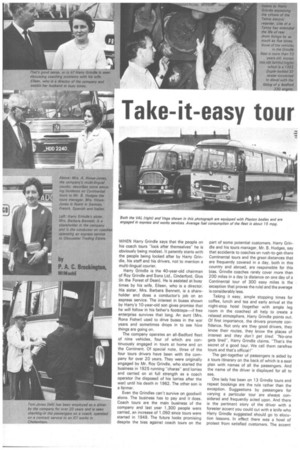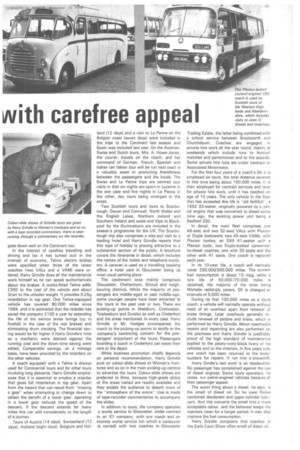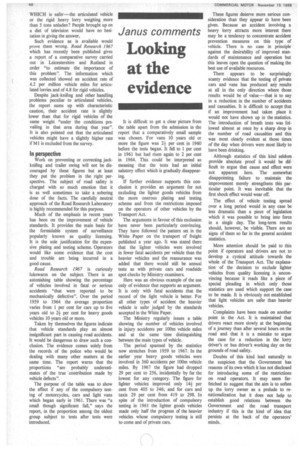Take-it-easy tour Nith carefree appeal
Page 46

Page 47

Page 48

If you've noticed an error in this article please click here to report it so we can fix it.
WHEN Harry Grindle says that the people on his coach tours "look after themselves" he is obviously being modest. It patently starts with the people being looked after by Harry Grindle, his staff and his drivers, not to mention a multi-lingual courier.
Harry Grindle is the 40-year-old chairman of Roy Grindle and Sons Ltd., Cinderford, Glos (in the Forest of Dean). He is assisted at busy times by his wife, Eileen, who is a director. His sister, Mrs. Barbara Bennett, is a shareholder and does a conductor's job on an express service. The interest in buses shown by Harry's 10-year-old son gives promise that he will follow in his father's footsteps—if free enterprise survives that long. An aunt (Mrs. Rona Fisher) used to drive buses in the war years and sometimes drops in to see hOw things are going on.
The company operates an all-Bedford fleet of nine vehicles, four of which are continuously engaged in tours at home and on the Continent. Of special note, three of the four tours drivers have been with the company for over 20 years. They were originally engaged by Mr, Roy Grindle, who started the business in 1925 running "charas" and lorries and carried on at full strength as a coach operator (he disposed of his lorries after the war) until his death in 1962. The other son is a farmer.
Even the Grindles can't survive on goodwill alone. The business has to pay and it does. Coach tours are the main business of the company and last year 1,300 people were carried, an increase of 1,050 since tours were started in 1949. The future looks promising despite the bias against coach tours on the part of some potential customers. Harry Grindle and his tours manager, Mr. B. Hodges, say that accidents to coaches on rush-to-get-there Continental tours and the great distances that are frequently covered in a day, both in this country and abroad, are responsible for this bias. Grindle coaches rarely cover more than 200 miles in a day (a distance on one day of a Continental tour of 300 easy miles is the exception that proves the rule) and the average is considerably less.
Taking it easy, ample stopping times for coffee, lunch and tea and early arrival at the night-stop hotel (together with ample leg room in the coaches) all help to create a relaxed atmosphere, Harry Grindle points out. Of first importance, the drivers promote confidence. Not only are they good drivers, they know their routes, they know the places of interest and they don't get tired. "No-one gets tired", Harty Grindle claims. "That's the secret of a good tour. We call them carefree
tours and that's official!" •
The get-together of passengers is aided by a tours itinerary on the back of which is &seat plan with names of all the passengers. And the name of the driver is displayed for all to see.
One lady has been on 13 Grindle tours and repeat bookings are the rule rather than the exception. Suggestions by passengers for varying a particular tour are always considered and frequently acted upon. And there is the pertinent story of the driver with a forester accent you could cut with a knife who Harry Grindle suggested should go to elocution lessons. In effect there was a howl of protest from satisfied customers. The accent
Colour-slide shows of Grindle tours are given by Harry Grindle to Women's Institutes and so on, with a tape-recorded .commentary. Harry is seen running through a commentary on the recorder.
goes down well on the Continent too.
In the interest of carefree travelling and driving and (as it has turned out) in the interest of economy, Telma electric brakes were specified when three of the latest coaches (two VALs and a VAM) were ordered. Harry Grindle does all the maintenance work himself so he can speak authoritatively about the brakes. A works-fitted Telma adds £350 to the cost of the vehicle and about 3cwt to the unladen weight. It provides 0.25g retardation in top gear. One Telma-equipped vehicle has covered 80,000 miles since 1964, and it is estimated that the retarder has saved the company £100 a year by extending the life of the service brake linings (up to fivefold in the case of the rear brakes) and eliminating drum cracking. The financial saving would be far higher if Harry Grindle's time as a mechanic were debited against the running cost and the down-time saving were added. Comparable savings, on a mileage basis, have been provided by the retarders on the other vehicles.
A coach equipped with a Telma is always used for Continental tours and for other tours involving long descents. Harry Grindle emphasizes that it is essential to employ a retarder that gives full retardation in top gear. Apart from the hazard that can result from "missing a gear" when attempting to change down to obtain the benefit of a lower gear, operating in a lower gear reduces the speed of the descent. If the descent extends for many miles this can add considerably to the length of a journey. land (12 days) and a visit to La Panne on the Belgian coast (seven days) were included in the trips to the Continent last season and Spain was included last year. On the Austrian, Swiss and Dutch tours, Mrs. A. Howe-Jones, the courier, travels on the coach, and her command of German, French, Spanish and Italian (an Italian tour will be run next year) Is a valuable asset in promoting friendliness between the passengers and the locals. The Swiss and La Panne trips are centred tour visits in that six nights are spent in Lucerne in the one case and five nights in La Panne in the other, day tours being arranged in the areas.
TwO Scottish tours and tours to Scarborough, Devon and Cornwall, North Wales and the English Lakes, Northern Ireland and Southern Ireland and week-end trips to Blackpool for the illuminations are included in the season's programme for the UK. The Scarborough trip also comprises a stay-put visit to a leading hotel and Harry Grindle reports that this type of holiday is proving attractive to a substantial section of the public. A brochure covers the itineraries in detail, which includes the names of the hotels and telephone numbers. A caravan is used as a travelling booking office, a hotel yard in Gloucester being its most usual parking place.
The catchment area mainly comprises Gloucester, Cheltenham, Stroud and neighbouring districts. While the majority of passengers are middle-aged or past middle ago, some younger people have been attracted to the tours in the past year or two. There are picking-up points in Westbury, Cirencester, Tewkesbury and Dursley as well as Cinderford and the areas mentioned. In every case, Harry Grindle or Mr. Hodges accompanies the coach to the picking-up points to testify to the company's continuing concern for the passengers' enjoyment of the tours. Passengers boarding a coach in Cinderford can leave their cars at the depot.
While business promotion chiefly depends on personal recommendation, Harry Grindle puts on colour-slide shows at Women's Institutes and so on in the main picking-up centres to advertise the tours. Colour slideshows are preferred to films, because high-grade slides of the areas`visited are readily available and they enable the audience to absorb more of the "atmosphere of the scene". Use is made of tape-recorder commentaries to accompany the slides.
In addition to tours, the company operates a works service to Gloucester. under contract to an ICI company, with one coach and an express works service (on which a conductor is carried) with two coaches to Gloucester Trading Estate, the latter being combined with a school service between Brockworth and Churchdown. Coaches are engaged in private hire work all the year round, rnainly at weekends which include runs to football matches and pantomimes and to the seaside. Some private hire runs are under contract to Associated Motorways.
For the first four years of a coach's life it is
• employed on tours, the total distance covered in this time being about 100,000 miles. It is then employed for contract services and later for private hire work, until it has reached an age of 10 years. The only vehicle in the fleet that has exceeded this life is "old faithfull-, a 1952 33 seater, originally powered by a petrol engine that was converted to diesel some time ago, the existing power unit being a Bedford 330.
In detail, the main fleet comprises one 48-seat and two 52-seat VALs with Plaxton or Duple bodywork; two 45-seat VAMs, with Plaxton bodies; an SB5 41-seater with a Plaxton body: two Duple bodiedconvertedto-diesel coaches, one with 35 seats and the other with 41 seats. One coach is replaced each year.
In its 10-year life, a coach will normally cover 250,000/300,000 miles. The current fuel consumption is about 15 Mpg, whIle a tyre life of 50,000/70,000 miles is obtained, the majority of the tyres being Michelin radial-ply covers. Oil is changed at intervals of 5,000 miles.
During its first 100,000 miles as a tours coach, a vehicle will normally operate without need of an overhaul apart from renewal of brake linings. • Later overhauls generally [0dude renewal of pistons and liners, which is performed by Harry Grindle. Minor coachwork repairs and repainting are also performed on the premises and Harry Grindle is justifiably proud of the high standard of maintenance applied to the peony-ivory-black livery of his vehicles and to the interiors. In five years only one coach has been returned to the bodybuilders for repairs. It run into a snowdrift.
Harry Gindle's last word is on deodorants. No passenger has complained against the use of diesel engines. Some tours operators, he notes, run petrol-engined vehicles because of their passenger appeal.
The worst thing about a diesel, he says, is the smell of diesel oil. So he uses Redex combined deodorant arid upper-cylinder lubricant. And this converts the smell into a more acceptable odour, and (he believes) keeps the injectors clean for a longer period. It may also improve the fuel consumption.
Harry Grindle complains that coaches at the Earls Court Show often smell of diesel oil.
WHICH is safer—the articulated vehicle or the rigid heavy lorry weighing more than 5 tons unladen ? People brought up on a diet of television would have no hesitation in giving the answer,
Such evidence as is available would prove them wrong. Road Research 1967 which has recently been published gives a report of a comparative survey carried Out in Leicestershire and Rutland in order "to estimate the importance of this problem". The information which was collected 'showed an accident rate of 4.2 per million vehicle miles for articulated lorries and of 4.8 for rigid vehicles.
Despite jack-knifing and other handling problems peculiar to articulated vehicles, the report sums up with characteristic caution, their accident rate is slightly lower than that for rigid vehicles of the same weight "under the conditions prevailing in that area during that year". It is also pointed out that the articulated vehicles might have a slightly higher rate if M1 is excluded from the survey.
In perspective
Work on preventing or correcting jackknifing and trailer swing will not be discouraged by these figures but at least they put the problem in the right perspective. The subject of road safety is charged with so much emotion that it is as well sometimes to take a sobering dose of the facts. The carefully neutral approach of the Road Research Laboratory is highly recommended for this purpose.
Much of the emphasis in recent years has been on the improvement of vehicle' standards. It provides the main basis for the formidable system of surveillance popularly known as quality licensing. It is the sole justification for the expensive plating and testing scheme. Operators would like some evidence that the cost and trouble are being incurred in a good cause.
Road Research 1967 is curiously lukewarm on the subject. There is an astonishing table showing the percentage of vehicles involved in fatal or serious accidents "that were reported to be mechanically defective". Over the period 1959 to 1964 the average proportion varies from 1 per cent for cars up to five years old to 2+ per cent for heavy goods vehicles 10 years old or more.
Taken by themselves the figures indicate that vehicle standards play an almost insignificant part in causing road accidents. It would be dangerous to draw such a conclusion. The evidence comes solely from the records of the police who would be dealing with many other matters at the same time. The report warns that the proportions "are probably underestimates of the true ' contribution made by vehicle defects".
The purpose of the table was to show the effect if any of the compulsory testing of motorcycles, cars and light vans which began early in 1961. There was "a small though significant fall," says the report, in the proportion among the oldest group subject to tests after tests were introduced.




















































































































